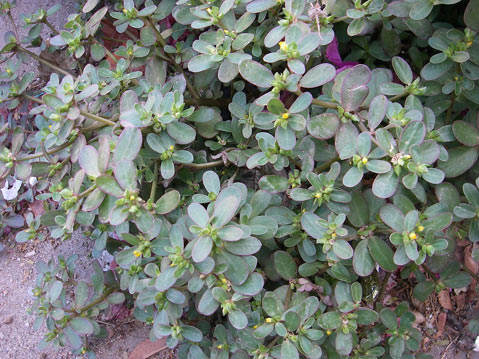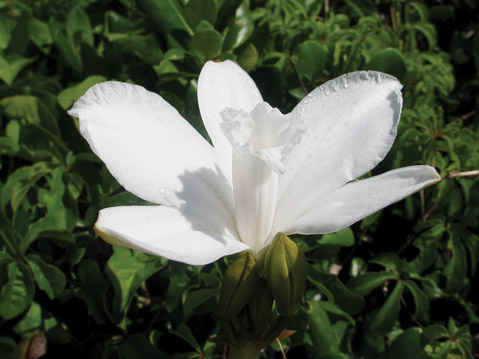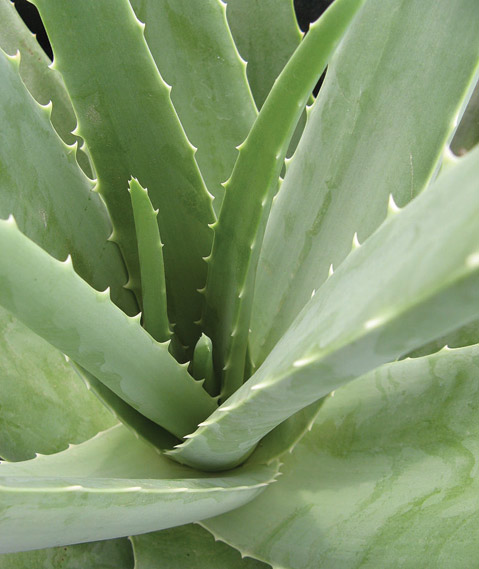Edible Succulents
Drought-Tolerant and Good in a Salad

Succulents are named for their fleshy, juicy leaves and roots and are respected by landscapers and florists for their ornamental properties and architectural magnitudes. However, their apt name makes an alternative suggestion — tasty — which seems almost unanimously overlooked and may serve as a reminder that a succulent’s use on the table should not be restricted to a vase.

Sandra Russell of the Santa Barbara Cactus & Succulent Society (SBCSS) pointed out that purslane, for example, is well suited to a salad bowl and is easy to find locally as an unkempt weed. Purslane can be eaten fresh, steamed, or sautéed and can replace spinach in most recipes. It also contains more omega-3 fatty acids than any other leafy vegetable plant.
Nopalitos are the edible young paddles of the prickly pear and are popular in traditional Mexican dishes, from soups to breakfast burritos. The cactus spans much of North America, reaching as far north as Manitoba, where it can withstand 30-degree-below weather and long-lasting droughts.
The fruits of a Peruvian apple and Indian fig cactus have delicate fruity tastes and can be eaten raw. In fact, the flowers and fleshier fruits of all true cacti are thought to be edible. Biting into any part of a cactus can be tricky, though, so before consuming any spiny flowers or fruits, do remember that it is necessary to carefully remove all the glochids.
If eating succulents still sounds a little too bizarre, then consider that pineapple (a bromeliad) and dragonfruit (a cactus) are often considered succulents. “The succulent term is really elastic. It might mean one thing to one person and may not mean something to another,” said the SBCSS’s Jim Foster in a recent interview with The Santa Barbara Independent.
Foster’s definition of a succulent includes one of the most ubiquitous ingredients in cooking — onions — with varieties like cipollini and pearl taking center stage at some of California’s Michelin-rated restaurants. His definition also includes the beloved Mexican orchid baking spice vanilla.

Succulents not only make their way into culinary dishes: They also star in high-end spirits. Tequila and its Weber’s blue agave origins may not be surprising, but one Californian distiller offers an original take on a succulent spirit with its specially crafted Chareau Aloe Vera Liqueur, which is made primarily from aloe vera. The distiller’s website says that aloe vera is not an agave, as many expect, but rather a succulent lily. They also suggest cocktail recipes that mix melons, citruses, and other alcohols — like sparkling wine and absinthe — with Chareau to create intoxicants so elegant that they are to be served with edible flower ice cubes.
Foster admitted that succulents may still be underappreciated for their edible value, but he added a warning to any garden or wilderness foragers hoping to add a little something special to their next cooking experiment. “Many plants make alkaloids as a defense,” said Foster, a chemist. “They can either mechanically keep things away by virtue of thorns or other structures, or they can make their own poison. That’s why the incidence of toxic plants exceeds that of edibles.”
Russell furthers this idea by offering sound advice to those more confident succulent samplers. “To go out and just chomp on any succulent is not recommended. You want to make sure you’re eating things that are healthful for you, not just novelties,” she said.
As with all edible plants, it is important to use correct identification methods and to make sure that anything you plan to eat is generally recognized as safe for consumption. It is also important to realize that individuals may react differently to certain plants.
However, with creativity reigning in the modern kitchen and cooks looking for ways to diversify their tables with unusual tastes and decorative garnishes, they might not need to go farther than an exploration of a succulent garden.



